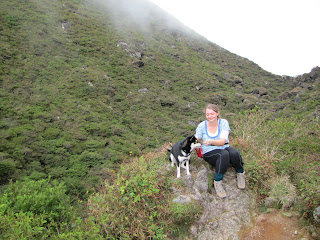 |
| If you like mushrooms, cooking in Japan is fun! |
The first thing you need to understand is that the western concept of vegetarianism is based on classifications and assumptions that do not exist in Japanese culture and which are challenging to communicate. You cannot simply say “I’m a vegetarian” or “I’d like this without meat” and expect to get a vegetarian meal. There are some ingrained assumptions that I have which have caused a few unpleasant experiences, especially the idea of tofu as a meat replacement. I bought a packet of “tofu-burger helper” and happily made some burgers only to realise upon tasting them that the mix contained prawn flakes. Similarly I have twice ordered “tofu steak” at different restaurants and both times the tofu can smothered in a meat sauce. One needs to be aware of one’s own assumptions as well as trying to understand the assumptions of the people one is speaking to. I once asked a waitress what she could recommend that didn’t contain meat. She suggested “hanbaagu”, a large rissole (or Salisbury steak for Americans). That’s right, to her “vegetarian” meant “plate of mince”. On another occasion I asked for a BLT without the bacon, saying “I can’t eat bacon”. The sandwich came out with sliced ham. Then you get people who swing the other way. I can’t count the number of times people I work with have exclaimed in surprise that I “can drink coffee even though” I am vegetarian. A teacher brought a homemade cake to the staffroom at the school of a friend and served it to everyone but her, saying “this has brown sugar so you can’t eat it”. My friend isn’t even vegetarian, she just doesn’t eat fish. To this day we haven’t figured that one out.
To calibrate your expectations to an appropriate setting, have a read of these two articles.
THIS ONE Has useful phrases and a list of resources.
THIS ONE is a more general piece with some discussion of Japanese native vegetarian tradition and some amusing anecdotes.
OK, you should have more realistic expectations now. This is important, because there is a pervasive misconception in the English speaking world that a lot of Japanese food is vegetarian, or at least “healthy”. Neither is really true. However, it is not all that difficult to get by as a vegetarian in Japan (especially if you live here and can cook for yourself). Before I go any further with this I have to lay out my disclaimers: I am not always 100% attentive. If I don’t have a lot of choice I will eat miso soup despite knowing that the broth contains fish. I use tomato ketchup in restaurants (which also contains fish product in Japan). When I buy pastries I don’t ask if they are made with lard (they often are). I eat deserts with gelatine in. While I do not knowingly recommend anything on this blog that is not vegetarian I am not promising to have fully researched the background of every ingredient and dish. Please do your own research before eating anything (and feel very free to share that research with me)! Likewise, I am not a fluent or even particularly high-level Japanese speaker. If you notice mistakes or mistranslations do please let me know.
Talking about vegetarianism
To most Japanese people “vegetarian” means someone who eats lots of vegetables. There’s a jingle playing on loop in the produce section of my local supermarket entreating everyone to be a vegetarian. When I first lived in Japan I used to say that I couldn’t eat meat or ask for food without meat. Using that word (肉) got me fish, prawns, mince meat, caviar, bacon, ham and sausages. You’ll read a lot of English speakers joking or making fun of Japanese people for thinking that “bacon is a vegetable”. That is not what is happening. 肉 is translated as meat but the real meaning is much narrower. I would say that it is closer to “muscle”, or maybe the old fashioned term “flesh”. No one thinks that bacon is a vegetable (although it often comes in salads), but it isn’t肉 either. Bacon is bacon. Fish is fish. So my next approach was to list everything: “I can’t eat fish, seafood, bacon, ham, meat or octopus. I can eat eggs but only bird eggs, not fish eggs.” This was time consuming and pretty ineffective because people tended to take it very literally. After giving this list I was served offal and tofu with fish flakes on top. For a long time I ate exclusively at Italian and Indian restaurants (both of which are plentiful pretty much everywhere and always have vegetarian options). This led me to gain a huge amount of weight (not blaming the cuisines themselves, it just tends to work out that you mainly get carbs that way). After a few years I am able to find something I can eat or get a modification to a dish at most places and even get vegetarian dishes at work functions. I think it’s more to do with gaining familiarity with my neighbourhood restaurants than learning any magical phrase unfortunately for my readers, but at least I am example that it can work out (even if you don’t speak fluent Japanese).
Here are some useful phrases from a Seek Japan article, just keep in mind the limitations I've discussed above about how some of these words can be interpreted:
Can you make this without meat?
Kono ryouri o niku nuki de tsukuremasu ka.
この料理を肉ぬきで作れますか。
Can you recommend a vegetarian dish?
Osusume no bejitarian menyuu wa arimasu ka.
おすすめのベジタリアン・メニューはありますか。
I do not eat any meat at all.
Watashi wa niku to sakana o mattaku tabemasen.
私は肉と魚を全く食べません。
I am allergic to meat and fish.
Watashi wa niku ya sakana ni taishite arerugii ga arimasu.
私は肉や魚に対してアレルギーがあります。
Could you make this without katsuobushi?
Kore o katsuobushi nuki de tsukuremasu ka.
これを鰹節ぬきで作れますか。
I do not eat meat, dairy or eggs.
Watashi wa niku, sakana, nyuseihin, tamago o tabemasen.
私は肉、魚、乳製品、玉子を食べません。
I can eat tofu, egg, cheese, natto, konnyaku, mochi and all vegetables.
Watashi wa toufu, tamago, chiizu, nattou, konnyaku, mochi, soshite yasai wa suki kirai naku tabemasu.
私は豆腐、玉子、チーズ、納豆、こんにゃく、もち、そして野菜は好き嫌いなく食べます。
If you live (or are preparing to live) in Japan
Online shopping is your friend. Foreign Buyers’ Club is the site I use most often. It is divided into two stores, one in Japan and one that ships from the US. The Japanese store ships within a week but has a smaller range, while the US store has a much larger inventory but takes over a month to arrive. I stock up on frozen vegetables for quick meals, as well as Amy’s vegetarian products, nutritional yeast and vital wheat gluten for making seitan.
Ambika stocks everything Indian. I make quite a lot of Indian food and I need my spices in bulk. This site also have good value rice (which is nice to get delivered because it is heavy) and gives out Bollywood DVDs when you place a large order!
Tengu Natural Foods is a site I haven’t used but it is popular with a lot of vegetarians. It carries a lot of vegan ingredients like nut butters, as well as organic baby food and environmentally friendly cleaning products.
See also: Flying Pig, Yoyo Market.
UPDATE: Just read a great article over here on having fruit and vegetables (including organic) delivered regularly.
Decide your dedication level
This is a tricky one, but something you need to put some thought into. Will you eat non-vegetarian cheese and cage-farmed eggs? Will you eat vegetables that have been cooked in broth that contains a small amount of fish-stock? If you find yourself in a difficult situation, can you eat a dish that contains meat but leave the meat? That last question may sound bizarre (I assume most vegetarians wouldn’t usually contemplate it) but I was once stuck in an isolated mountain village for two days and nights with nothing I could eat except white rice (it’s a long story). By lunch the second day (yeah, I can’t go long without food) I couldn’t take it and ate a Japanese curry with the chunks of beef taken out. If you can cope with eating a bit of fish-stock your life will be much easier, sad to say. If you are not willing to make any concessions you’ll be fine, but you will have to cook at home most of the time (or eat a lot of white rice).
Work and food (for ALTs)
I’m an ALT at Junior High and Elementary Schools, where school lunch is provided and ALTs are expected to eat with the students. I contacted my contracting organisation before I had even arrived in Japan to let them know about my vegetarianism. I eat with the children but bring a packed lunch. My lunches are a source of endless fascination for the students (and many teachers too), and has been a good starting point for conversation. I’ve only had occasional awkward moments when teachers try to give me parts of school lunch and then get huffy when I refuse (because they assume I don’t like Japanese food). It’s always been ok after I explain that I am not rejecting their culture, I just have a religious prohibition against meat (untrue, but it is simpler to explain and causes less disgruntlement). The only trouble with this is that I usually try not to let the students hear me speak Japanese, and in this situation the teachers force me to. It can be depressing eating a cold lunch while surrounded by steaming hot food, but I’ve invested in a range of thermos lunch boxes to get me through the winter. It can also be hard to stomach my lunch while watching the kids eat some of the stuff they eat, but that’s another story! The only caution I have is to be consistent. Because I was clear from the beginning there were no problems, but I have heard of ALTs having problems when they initially ate school lunches but then tried to cancel them. One friend has been able to stop her school lunches fine, but a couple of others were subjected to animosity from co-workers.
Work parties are the second place food becomes an issue. For my first year I used to pay up for work dinners and just try to drink my money’s worth (which is hard, because alcohol is cheap here). At one function the wait-staff went and told the manager that I wasn’t eating anything and he came out and said that they could have prepared a special menu if I had given them notice. I’d never asked about this because I assumed that with a large group paying a set price for a menu that doing a special separate menu included in the package price would be impossible. For the next party I asked the organisers to ask for me but emphasised that I would still come even if the hotel couldn’t accommodate my request. The hotel double-checked about eggs and there were no problems. That was a year ago and I’ve never looked back. Even the time when we had the party at a Japanese-style inn with a fully Japanese menu (and waitresses in kimono) I was served my own delicious vegetarian course. So it is doable, you just need to ask. You can see some pictures of the kinds of things I get served over at this post all about enkai.
Continue Reading...



















